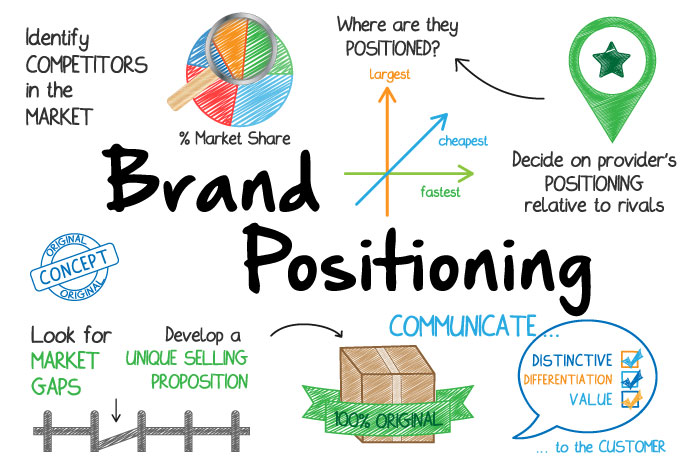


The objective of market positioning is to establish the image or identity of your brand, service or product so that consumers perceive it in a unique way.
But wait! What makes brand positioning different from brand identity, then?
Brand identity is the image you present to the outside world. This goes way beyond than just choosing the right logo and recognizable color schemes; it’s about all the things that come together to form your reputation. Brand identity encompasses everything from marketing materials to the quality of your products and services, how well you communicate with your customers online and how your front-line staff respond to inquiries..
Brand positioning, however, reflects where your brand is positioned in relation to the rest of the market. You’ll need to undertake a competitive analysis to really understand where you are and identify the strengths and weaknesses than can move you up or down the tables. Positioning your brand comes from identifying who your competitors are and the things you do differently (and the same).
Positioning your brand in such a highly competitive market is no easy task. You want your brand to stand out to your target audience in a way that gives it a great, long-lasting impression.
An effective brand positioning strategy is all about finding ways to differentiate your brand from competitors and establish the right emotional connection with your target audience – all while staying focused on how to make your service / product relevant.
This involves focusing on how your product or service addresses a certain need or solves a problem for customers. In other words, how your product/service gives a beneficial value. For example, if your company sells a software app, you might position this app based around its features such as – for example – helping users encrypt / decrypt their files/folders in a fast, highly efficient manner. Take a list of product features and easily tailor it to fit a specific client.
Your company can differentiate itself in the market by its competitive pricing. This involves either positioning as a premium brand or as an economical one, and is tied to the company’s pricing strategies. The premium brand positioning involves touting high quality and exclusivity. The economical brand position is about access and affordability.
In this positioning strategy, the product or service targets its use in specific situations. This strategy is most often applicable when the company – for example – offers some sort of fat-free or carbohydrate-free products aimed at people concerned with certain health-related problems.
This market positioning type focuses on how the company and its offerings are better than the competition. In this strategy, the business explicitly compares itself to competitors. Companies that use this approach may also employ phrases such as, "still the best, We go Above & Beyond, We Are Different… etc.
This type of positioning targets a specific group of customers and explains why the company’s offerings are directly relevant and applicable to this group. Examples here include how Johnson and Johnson’s baby shampoo positions itself as gentle for children, while Rexona body spray targets men and women.
To create an effective market positioning strategy, a company must:
This starts by determining the unique factors and attributes that set you apart from your competitors. In order to better attract clients and successfully position your brand online, you need to analyze your competitors, compare and contrast differences between you and them (i.e., identify their strengths and weaknesses relative to your offering), and find out the points that make you unique. In other words, you need to determine what you provide for your audience that no other brand delivers.
One of the main goals of having an online presence, or a website, is to capture the attention of potential clients and turn them into qualified leads. By creating a website with valuable, well-crafted content, you will be able to build your business’ credibility and drive your target audience to your website, promoting your online brand.
Remember to make proper use of long-tail keywords that your target audience would use to search for your services online. Without the use of proper keywords throughout your content, you end up targeting the wrong audience, or not driving a satisfying number of potential clients to your website.
This involves conducting a detailed market research so that you can thoroughly define your target audience and understand what their most preferable social platform(s) could be. For example, if your target audience is on Twitter, but not on LinkedIn, you should probably re-direct your focus on Twitter alone; and then maybe find a new channel other than LinkedIn to establish an online presence on. In other words, you should only join social networks where your target audience are present so you can save time and money, while also positioning your brand correctly on social media.
Sharing valuable content with your audience is one of the most essential aspects to positioning your brand online. Websites that attract the most audience are those where the content is constantly being added and renewed. Your target audience wants and expects to learn something new each time they visit your website and they consider those websites that do so as more valuable. Of course, your website content (such as blogs, news, events… etc.) should be shared across all your social channels, and it should always be directed towards your target audience so you can well position your brand online and in the market place.
Our skilled team can help you fully develop and implement an effective brand strategy that helps you achieve your goals in the best possible way.